Force and Pressure | Chapter 2 | 8th Science - Student Activities | 8th Science : Chapter 2 : Force and Pressure
Chapter: 8th Science : Chapter 2 : Force and Pressure
Student Activities
Activity 1
Fix a matrix of sharp pins on a wooden board in rows and columns. Take a big blown up balloon. Place it gently over the pins and place a small book on the top of the balloon. Will the balloon burst? Will the pins prick the balloon?
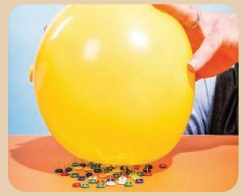
Answer:
Aim : To understand the effect of a force depends on the magnitude of the force and the area over which it acts.
Materials required : Sharp pins, wooden board, balloon.
Procedure :
(i) Fix a matrix of sharp pins on a wooden board in rows and columns.
(ii) Take a big blown up balloon.
(iii) Place it gently over the pins.
(iv) Place a small book on the top of the balloon.
(v) Observe what happens?
(vi) Will the balloon burst? Will the pins prick the balloon?
Inference :
(i) The balloon will not burst. If you prick the balloon with a single pin it will burst. But this did not happen even though many more pins were pricking the balloon.
(ii) A single pin produces a large pressure over a small area. But, when a large number of pins prick a body, each pin exerts very little pressure on the balloon, as the applied force gets distributed over a large surface of the body. So, the balloon will not burst.
Conclusion: We conclude that the effect of a force depends on the magnitude of the force and the area over which it acts.
More to know
Cooking in a place located at a higher altitude is difficult. Why? At a higher altitude, due to lack of atmospheric pressure the boiling point of a substance reduces. So, water boils even at 80°C. The thermal energy that is produced at this temperature is not sufficient enough for baking or cooking. So, cooking is difficult at higher altitude.
Activity 2
Take a conical flask and a well boiled egg, after removing its shell. Place the egg on the mouth of the flask. It will not enter the flask. Now take a piece of paper. Burn it and drop it inside the flask. Wait for a few seconds to burn fully. Now, keep the egg on the mouth of the flask. Wait for a few minutes. What do you observe?
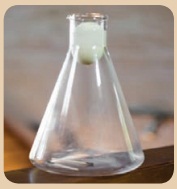
When the paper is burning in the flask, the oxygen present in the air inside the conical flask is used up for its combustion. This reduces the pressure of the air in the flask. The air in the atmosphere tends to occupy the low pressure region in the flask. So, it rushes through the mouth of the flask, thus pushing the egg into the flask.
Answer:
Aim : To realise the atmospheric pressure.
Materials required: Conical flask, boiled egg, piece of paper.
Procedure:
(i) Take a conical flask.
(ii) Take a well boiled egg, after removing its shell.
(iii) Place the egg on the mouth of the flask.
(iv) It will not enter the flask.
(v) Take a piece of paper.
(vi) Burn it and drop it inside the flask.
(vii) Wait for a few seconds, let it burnt fully.
(viii) Now keep the egg on the mouth of the flask.
(ix) Wait for a few minutes.
Observation: The egg placed at the mouth of the flask gets compressed and it falls into the flask, due to the atmospheric pressure.
Inference:
(i) When the paper is burning in the flask, the oxygen present in the air inside the conical flask is used up for its combustion. This reduces the pressure of the air in the flask. The air in the atmosphere tends to occupy the low pressure region near the flask.
(ii) So, it rushes through the mouth of the flask, thus pushing the egg into the flask. Eventually, the egg falls down to the bottom of the flask.
Activity 3
Take a plastic bottle. Punch three holes on its side in the same direction, but at different heights. Now pour some water into it and let it flow through the holes. Observe the flow of water. Water from the lowest hole comes out with the greatest force and the water from the topmost hole comes out with the least force.

Answer:
Aim : To understand that the pressure in a liquid varies with the depth of the point of observation in it.
Materials required : Plastic bottle, Water
(i) Plastic bottle
(ii) Water
Procedure :
(i) Take a plastic bottle.
(ii) Punch three holes on its sides in the same direction but at different heights.
(iii) Now pour some water into it and let it flow through the holes.
(iv) Observe the flow of water.
Observation:
i) The water comes out from all the holes with a different force and falls on the table at points that are at variable distances from the bottle.
(ii) Water from the lowest hole comes out with the greater force and falls at a point that is at the maximum distance from the bottle.
(iii) Water from the top most hole comes but with the least force and falls at the point that is at the minimum distance from the bottle.
Inference: This shows that the pressure is a liquid varies with the depth of the point of observation on it.
Answer 2 : Take a plastic bottle. Punch three holes on its side in the same direction, but at different heights. Now pour some water into it and let it flow through the holes. Observe the flow of water.
Inference : The water comes out from all the holes with a different force and falls on the table at points that are at variable distances from the bottle. Water from the lowest hole comes out with the greatest force and falls at a point that is at the maximum distance from the bottle. Water from the topmost hole comes out with the least force and falls at the point that is at the minimum distance from the bottle.
Reason: This activity confirms that the pressure in a liquid varies with the depth of the point of observation in it.
This activity confirms that the pressure in a liquid varies with the depth of the point of observation in it.
Activity 4
Take a glass tube that is open at both ends. Fix a rubber balloon at the lower end of the tube. Pour some water into the tube and observe the balloon. Now, pour some more water into the balloon and again observe the balloon. The balloon starts bulging outwards.
Answer:
Aim : To demonstrate that liquid exerts pressure at the bottom of its container depends on the height of the liquid column in it.
Materials required ; Transparent glass tube, balloon, water.
Procedure :
(i) Take a glass tube that is open at both ends.
(ii) Fix a rubber balloon at the lower end of the tube.
(iii) Put some water into the tube and observe the balloon.
(iv) Now, pour some more water into the balloon and again observe the balloon.
Observation : The balloon starts bulging outwards. The bulge increase with an increase in the height of the water column.
Inference: The pressure exerted by a liquid at the bottom of a container depends on the height of the liquid column in it.
Activity 5
Take a plastic bottle. Punch three holes on its sides at the same height from its base. Now, pour some water into it and let it flow through the holes. Observe the flow of the water. Water comes out from all the holes with the same force and falls on the ground/ table, at the same distance from the bottle.
Answer:
Aim : To demonstrate that liquid exerts equal pressure at same depth.
Material required : Plastic bottle, water.
Procedure :
(i) Take a plastic bottle.
(ii) Punch three holes on its sides at the same height from its base.
(iii) Now, pour some water into it and let it flow through the holes.
(iv) Observe the flow of the water.
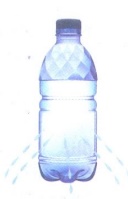
Observation : The water comes out from all the holes with the same force and falls on the ground / table, at the same distance from the bottle.
Inference : This activity confirms that liquids exert the same pressure in all directions at a given depth in their container.
Why dams are made stronger and broader at the bottom than at the top? Why do scuba divers wear a special suit while they go into deep sea levels?
Activity 6
Take a rubber ball and fill it with water. Make tiny holes on its surface with a pin at different points. Press anywhere on the ball. What do you observe?
Answer:
Aim : To demonstrate pressure applied on one point of liquid transmits equally in all directions.
Materials required : Rubber ball, water, pin.
Procedure :
(i) Take a rubber ball. Fill it with water.
(ii) Then take tiny holes on it with a pin at different points on its surface.
(iii) Press anywhere on the ball.
(iv) What do you observe?
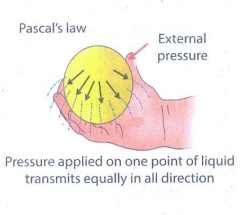
Observation : There are identical streams of water flowing in all directions from the holes.
Inference : This is due to the phenomenon that the pressure, which is applied on the liquid, is equally transmitted in all directions.
Activity 7
Take some water in a beaker and spread a tissue paper on the surface of the water. Gently place the paper clip on the tissue paper. Observe what happens to the paper pin after some time.
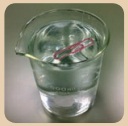
After a few moments the tissue paper will submerge and the paper clip will make a small depression on the surface of the water. It will instantly begin to float on the surface, even though it is denser than water.
Answer:
Aim : To understand about surface tension property of liquid.
Materials required : Glass beaker, water, paper clip, tissue paper.
Procedure :
(i) Take a paper clip. Take a beaker of water.
(ii) Take a tissue paper and spread it on the surface of the water.
(iii) Gently, place the paper clip on the tissue paper.
(iv) Observe what happens to the paper pin after some time.
Observation : After a few moments the tissue paper will submerge and the paper clip will make a small depression on the surface of the water. It will instantly begin to float on the surface, even though it is denser than water.
Inference : This is due to the water molecules on the surface, which tend to contract themselves like the molecules of an elastic membrane. A force exists on them, which tends to minimize the surface area of water. The paper clip is balanced by the molecules on the water surface that is now behaving like a stretched elastic membrane. So, it does not submerge.
Activity 8
Take a small quantity of different kinds of liquid like coconut oil, honey, water and ghee etc. , Place one drop of each liquid on a separate glass plate. Now gently raise one end of the glass plate, so as to allow the liquid to slide down the smooth surface of the plate. Observe the speed of each liquid.
Answer:
Aim : To understand about the frictional force between the layers of liquid in motion.
Materials required : Different kinds of liquid (coconut oil, honey, water, ghee), glass plates - 4 nos.
Procedure :
(i) Take a small quantity of different kinds of liquid like coconut oil, honey, water and ghee etc., in a cup.
(ii) Place one drop of each liquid on a separate glass plate.
(iii) Next, gently raise one end of the glass plate, one by one, so as to allow the liquid to slide down the smooth surface of the plate.
(iv) Observe the speed of each liquid.
Observation : Each liquid moves with a different speed. Water flows faster than other liquids. Coconut oil flows with a moderate speed. Ghee flows very slowly.
Inference : Between the layers of each liquid, in motion, there is a frictional force parallel to the layers of the liquid. This frictional force opposes the motion of the liquid layers while they are in motion.
ACTIVITY
Make two groups of students. Let
them stand along a straight line, one behind the other, on a playground. Start
the game of “tug of war” with a rope. Observe the movement of the students.
Who are the winners?
Answer:
Aim: To understand the net effect of two forces acting on a body in
opposite directions.
Procedure:
(iv) Make two group of students.
(v) Let them stand along a straight line, one behind the other,
on a playground.
(vi) Start the game of ‘tug of war’ with a rope.
(vii) Observe the movement of the students.
Inference:
(i) The rope will move in the direction of the team that applies
more force.
(ii) If the two teams apply the same force, the rope will not
move at all.
ACTIVITY
Fill two identical syringes with
water. Connect them with a plastic tube. Press gently on one end of a piston.
What do you observe?
Answer:
Aim: To understand that the pressure exerted on a liquid at rest is
transmitted equally to other portions of the liquid.
Materials
required : Two identical syringes, water.
Procedure
:
(i) Fill two identical syringes with water. Connect them with a
plastic tube.
(ii) Press gently on one end of a piston.
(iii) What do you observe?

Observation: If one piston is pressed downward then the other piston will
move up slightly, depending on the pressure given on the first piston.
Inference:
The pressure exerted on a liquid at rest is transmitted equally
to other portions of the liquid.
ACTIVITY
Answer:
Aim: To understand that the rolling friction is less than the
sliding friction.
Materials
required: Book, table (rough surface),
cylindrical pencils.
Procedure
:
(i) Push or slide a book on a rough surface. It is difficult to
push it. Isn’t it?
(ii) Now, keep some cylindrical pencils underneath the book.
(iii) Again, push it. It is easy to move the book. Why?
Observation: When you push the book, the pencils roll in the direction of
the applied force. They prevent the contact of the book with the rough surface.
Rolling pencils offer the least amount of friction.
Inference: So, it is easy to displace the book in comparison with sliding
it on the table. This method is often used in moving heavy wood from one place
to another.
ACTIVITY
Answer:
Aim To understand the effect
of the force of friction, which increases as the roughness the surface
increases.
Materials
required : Paper, glass, cotton cloth, wood,
table, books, newspaper, writing pad, glass marbles in a bouch.
Procedure
:
(i) Arrange some notebooks one over the other to form a
platform, on a table.
(ii) Keep a wide scale, as a slide, such that one of its ends
rests on the pile of books.
(iii) Take different kinds of materials like cotton cloth,
plastic paper, newspaper, writing pad etc.
(iv) Place some glass marbles in a bowl placed on the table.
Experiment
: First, keep a rectangular piece of paper near the end of the
scale, which is in contact with the table. Now, release a glass marble from the
top end of the scale such that it rolls down the scale. Allow the marble to
roll over the piece of paper and finally, come to rest. Replace the rolling
surface by placing the plastic sheet, wooden plank, cotton cloth.
Observation: Measure the distance travelled by the marble over the
different objects using the meter scale.
Inference: In different objects each trial measure the distance travelled
by the glass marble is tabulated. Tabulate the distance covered by the marble
over different surfaces is different.
Related Topics